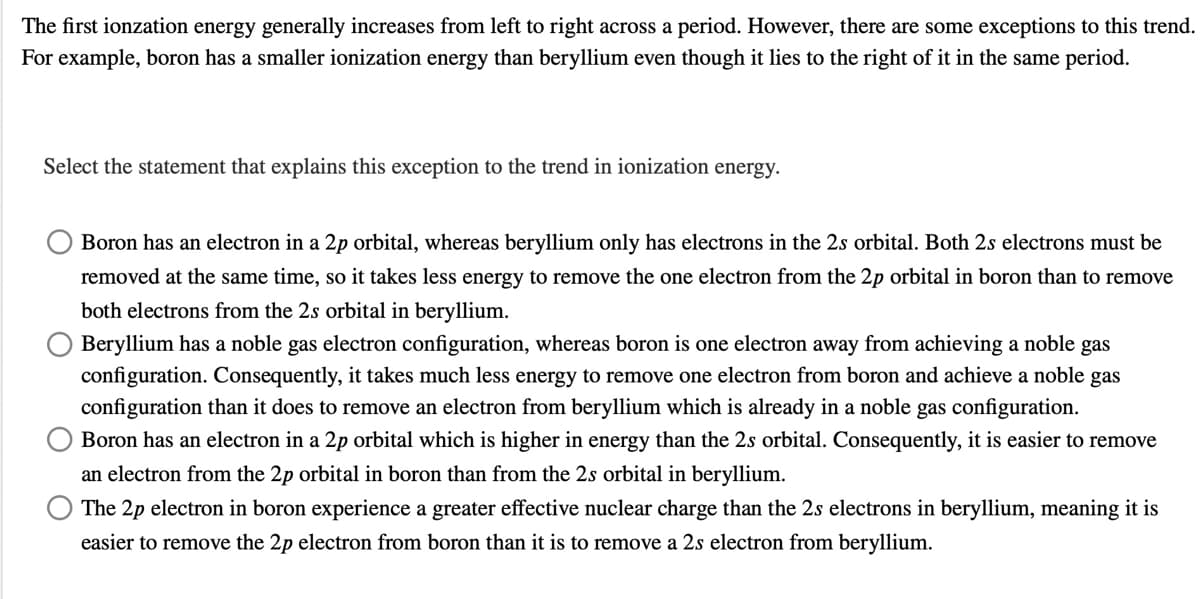The first ionzation energy generally increases from left to right across a period. However, there are some exceptions to this trend. For example, boron has a smaller ionization energy than beryllium even though it lies to the right of it in the same period. Select the statement that explains this exception to the trend in ionization energy. Boron has an electron in a 2p orbital, whereas beryllium only has electrons in the 2s orbital. Both 2s electrons must be removed at the same time, so it takes less energy to remove the one electron from the 2p orbital in boron than to remove both electrons from the 2s orbital in beryllium. Beryllium has a noble gas electron configuration, whereas boron is one electron away from achieving a noble gas configuration. Consequently, it takes much less energy to remove one electron from boron and achieve a noble gas configuration than it does to remove an electron from beryllium which is already in a noble gas configuration. Boron has an electron in a 2p orbital which is higher in energy than the 2s orbital. Consequently, it is easier to remove an electron from the 2p orbital in boron than from the 2s orbital in beryllium. The 2p electron in boron experience a greater effective nuclear charge than the 2s electrons in beryllium, meaning it is easier to remove the 2p electron from boron than it is to remove a 2s electron from beryllium.
The first ionzation energy generally increases from left to right across a period. However, there are some exceptions to this trend. For example, boron has a smaller ionization energy than beryllium even though it lies to the right of it in the same period. Select the statement that explains this exception to the trend in ionization energy. Boron has an electron in a 2p orbital, whereas beryllium only has electrons in the 2s orbital. Both 2s electrons must be removed at the same time, so it takes less energy to remove the one electron from the 2p orbital in boron than to remove both electrons from the 2s orbital in beryllium. Beryllium has a noble gas electron configuration, whereas boron is one electron away from achieving a noble gas configuration. Consequently, it takes much less energy to remove one electron from boron and achieve a noble gas configuration than it does to remove an electron from beryllium which is already in a noble gas configuration. Boron has an electron in a 2p orbital which is higher in energy than the 2s orbital. Consequently, it is easier to remove an electron from the 2p orbital in boron than from the 2s orbital in beryllium. The 2p electron in boron experience a greater effective nuclear charge than the 2s electrons in beryllium, meaning it is easier to remove the 2p electron from boron than it is to remove a 2s electron from beryllium.
Chemistry: An Atoms First Approach
2nd Edition
ISBN:9781305079243
Author:Steven S. Zumdahl, Susan A. Zumdahl
Publisher:Steven S. Zumdahl, Susan A. Zumdahl
Chapter2: Atomic Structure And Periodicity
Section: Chapter Questions
Problem 9RQ
Related questions
Question

Transcribed Image Text:The first ionzation energy generally increases from left to right across a period. However, there are some exceptions to this trend.
For example, boron has a smaller ionization energy than beryllium even though it lies to the right of it in the same period.
Select the statement that explains this exception to the trend in ionization energy.
Boron has an electron in a 2p orbital, whereas beryllium only has electrons in the 2s orbital. Both 2s electrons must be
removed at the same time, so it takes less energy to remove the one electron from the 2p orbital in boron than to remove
both electrons from the 2s orbital in beryllium.
Beryllium has a noble gas electron configuration, whereas boron is one electron away from achieving a noble gas
configuration. Consequently, it takes much less energy to remove one electron from boron and achieve a noble gas
configuration than it does to remove an electron from beryllium which is already in a noble gas configuration.
Boron has an electron in a 2p orbital which is higher in energy than the 2s orbital. Consequently, it is easier to remove
an electron from the 2p orbital in boron than from the 2s orbital in beryllium.
The 2p electron in boron experience a greater effective nuclear charge than the 2s electrons in beryllium, meaning it is
easier to remove the 2p electron from boron than it is to remove a 2s electron from beryllium.
Expert Solution
This question has been solved!
Explore an expertly crafted, step-by-step solution for a thorough understanding of key concepts.
This is a popular solution!
Trending now
This is a popular solution!
Step by step
Solved in 2 steps

Knowledge Booster
Learn more about
Need a deep-dive on the concept behind this application? Look no further. Learn more about this topic, chemistry and related others by exploring similar questions and additional content below.Recommended textbooks for you

Chemistry: An Atoms First Approach
Chemistry
ISBN:
9781305079243
Author:
Steven S. Zumdahl, Susan A. Zumdahl
Publisher:
Cengage Learning


Chemistry
Chemistry
ISBN:
9781305957404
Author:
Steven S. Zumdahl, Susan A. Zumdahl, Donald J. DeCoste
Publisher:
Cengage Learning

Chemistry: An Atoms First Approach
Chemistry
ISBN:
9781305079243
Author:
Steven S. Zumdahl, Susan A. Zumdahl
Publisher:
Cengage Learning


Chemistry
Chemistry
ISBN:
9781305957404
Author:
Steven S. Zumdahl, Susan A. Zumdahl, Donald J. DeCoste
Publisher:
Cengage Learning

General Chemistry - Standalone book (MindTap Cour…
Chemistry
ISBN:
9781305580343
Author:
Steven D. Gammon, Ebbing, Darrell Ebbing, Steven D., Darrell; Gammon, Darrell Ebbing; Steven D. Gammon, Darrell D.; Gammon, Ebbing; Steven D. Gammon; Darrell
Publisher:
Cengage Learning

Introductory Chemistry: A Foundation
Chemistry
ISBN:
9781337399425
Author:
Steven S. Zumdahl, Donald J. DeCoste
Publisher:
Cengage Learning

Chemistry & Chemical Reactivity
Chemistry
ISBN:
9781337399074
Author:
John C. Kotz, Paul M. Treichel, John Townsend, David Treichel
Publisher:
Cengage Learning